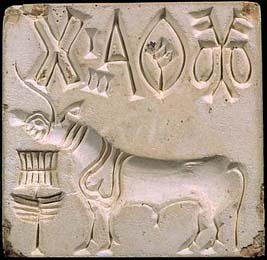| Art History 207~~Fall 2000 |
 |
unicorn cylinder seal *
3000-1500 BCE
| Study Questions |
| Week 1 |
| Harappan Culture |
| 1. Why do you think that the people of the Harappan Culture represented animals so often in their art? For these people, what was apparently beautiful, or significant, about those animals?
2. Several of the stone and ceramic figures from the Harappan Culture are the remains of dancers with manipulable limbs. Why might such figures have been considered important, or even beautiful? 3. The small red sandstone male torso from Harappa certainly represents what the people of that day considered beautiful, or handsome; but we might not agree with that judgment. What characteristics of the human form seem to them to have been so pleasing? +1. The animals on the cylinder seals from the Harappan Culture frequently convey a sense of considerable vitality, even though the molded figures were very small. How do they convey that sense of life? 5. What are the important elements to understand in the strange 'proto-Shiva' seal from the Harappan Culture? 6. Socially and ritually, what are the significant aspects of the great bath found at Mohenjo-Daro? Sites of the Week :
a) Indus River Further Readings:Wheeler, Mortimer, Civilizations of the Indus Valley and beyond. New York, McGraw-Hill [1966] Parpola, Asko. Deciphering the Indus script. New York, NY: Cambridge University Press, 199+1. Whitehouse, Ruth. The First Cities. Oxford [Eng.]: Phaidon; New York: E.P. Dutton, 1977. |
| The Vedic period: sources of Hindu belief and art |
| The Vedic Period 1. Thinking in your own way, without trying to become a philosopher, can you explain the Vedic understanding of the Self, or of Reality, in contrast to our Western conceptions? How would you explain the fundamental aspect of these conceptions to someone who knew nothing about Vedism, Buddhism, or Hinduism? The beginnings of Buddhism 2. Think about the historical Buddha: what kind of childhood did this person have? Why should he have decided to leave his community to live such an ascetic life of meditation? 3. In the Milindapanha, King Menander comes to understand the nature of individuality by reference to an object like a chariot. What is that nature of individuality? Can you apply it to yourself? +1. According to Nagasena, how do things - people, animals, plants, and so forth - acquire their specific character and appearance? Is it genetics? a divine source? or what? 5. Notice the kinds of things - material things - that are used for examples or similes in the selections from early Buddhist texts. How would you generalize about these things? Are they valuable? beautiful in appearance? of extreme rarity? Further Readings:Tull, Herman Wayne. The Vedic origins of karma : cosmos as man in ancient Indian myth and ritual. Albany : State University of New York Press, c.1989. Santucci, James A. An outline of Vedic literature. Missoula, Mont. : Published by Scholars Press for the American Academy of Religion, c.1976. Zimmer, Heinrich Robert. Myths and Symbols Indian Art and Civilization. Princeton University Press [1972, c.19+16] |


